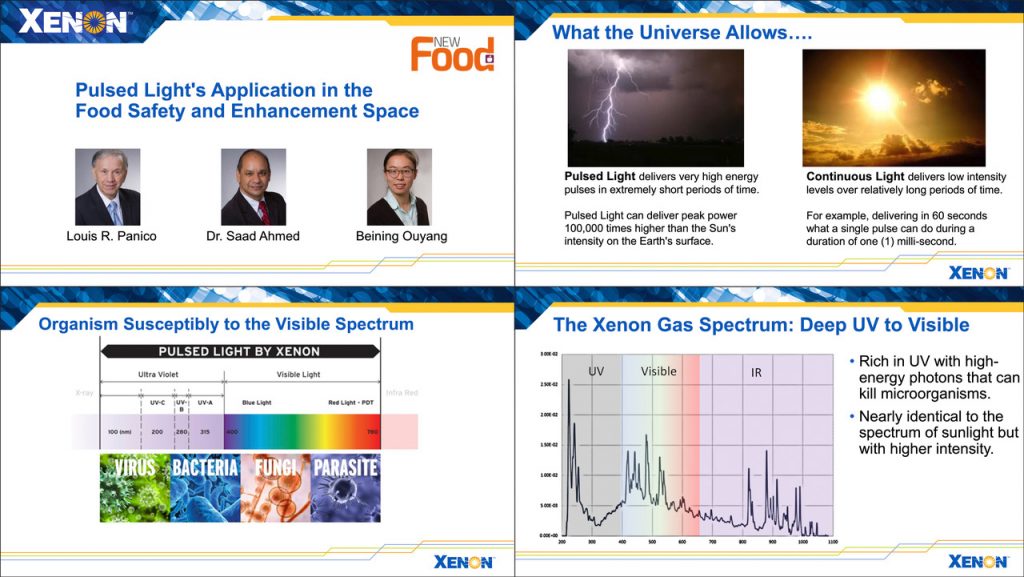A Webinar Presented by XENON and New Food Magazine
On October 21, 2020, XENON presented a webinar on the use of Pulsed Light for food safety and enhancement. XENON’s leading experts, including CEO, Lou Panico, Chief Scientist and VP of Operations, Saad Ahmed, and XENON Microbiologist, Beining Ouyang conducted the hour-long presentation, which included a lively Q&A period at its conclusion. Links to the presentation and related documentation are provided at the end of this blog. Here is a summary of the presentation.
What is Pulsed Light?
Pulsed Light is defined as high-energy pulses of light from a xenon light source. A single pulse of xenon light produces a large volume of photons in a short period of time, not unlike a lightning bolt. A single milli-second burst of Pulsed Light is equivalent to the energy that would require 60 seconds of continuous light. That power produces a variety of chemical reactions without generating heat that would damage the product being treated. Xenon light produces a full-spectrum, from ultraviolet to visible infrared — a bandwidth nearly identical to sunlight, but with much higher intensity. These characteristics are what make Pulsed Light uniquely able to destroy nearly every type of pathogen including viruses, bacteria, fungi, and parasites. How does it work? Pulsed Light attacks cells by a variety of mechanisms. For example, UV-A light damages a cell’s membrane while UV-B damages the backbone of the DNA, UV-C damages a cell’s protein and thiamine, and visible infrared (VIS-IR) attacks the cell, resulting in water loss. This combined attack on a cell’s structure overcomes the ability of a cell to repair itself through a mechanism called Enzymatic Photoreactivation. When Pulsed Light kills a pathogen, it stays dead, and with no residuals. Where is Pulsed Light used in the food industry? Pulsed Light is a fast, chemical-free technology that can reduce pathogen contamination on conveyors and food packaging. Other known applications of interest to the food industry include shoe sanitization, decontamination of shipping containers and storage spaces, and disinfection of air and high touch surfaces using robotic and/or fixed-position products. In addition to its food safety benefits, research has shown that many food products are enhanced by exposure to Pulsed Light. For example, exposing mushrooms to Pulsed Light results in Vitamin D values that exceed the Recommended Daily Allowance as determined by The Food and Nutrition Board of the National Research Council. And many foods see their shelf-lives extended by treatment with Pulsed Light. Where can it be installed? Pulsed Light systems can be designed to fit within any food processing facility and installed at point along the food production process. Multiple lamps can be installed to eliminate shadowing and with a variety of lamp shapes and sizes available, XENON is able to develop a customized Pulsed Light solution for nearly any food safety application. XENON has developed a number of Pulsed Light products with the food industry in mind.- The XENON Z-1000 Modular Sterilization System allows for customized Pulsed Light solutions for a wide range of applications.
- The XENON Z-2000 Conveyor Decontamination System provides continuous disinfection of stainless-steel conveyor belts to supplement, or replace existing cleaning methods.
- The XENON Z-3000 Pass-Through is designed to disinfect objects as they pass between non-sterile and sterile environments.
- The XENON X-1100 Benchtop Research System is a low-cost, benchtop Pulsed Light system used for testing and validation.
